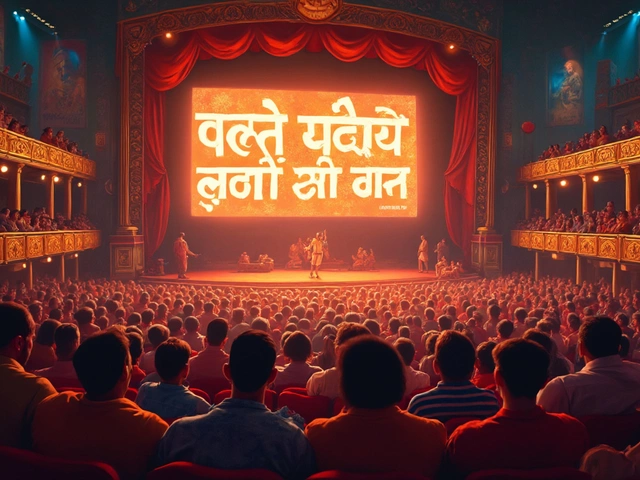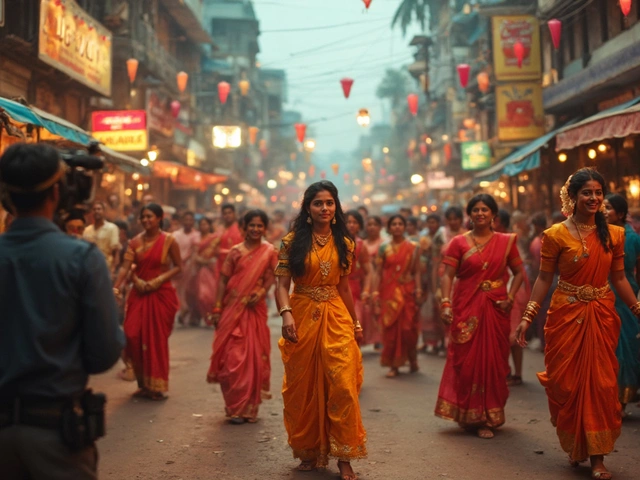
The South Indian film industry is a fascinating tapestry of vibrant creativity and cultural storytelling, with diverse segments dominating the Indian cinematic landscape. This article aims to unravel the captivating world of South India's cinema, where Tamil and Telugu films often make waves with grand productions and compelling narratives.
While Tamil cinema, known as Kollywood, boasts a rich tradition of powerful stories and iconic stars, the Telugu industry, or Tollywood, is famed for its mass appeal and blockbuster hits. Both industries command large fan followings, contribute significantly to the economy, and bring unique storytelling flavors to the table.
Yet, the story doesn't end here. Kannada and Malayalam cinemas, though smaller in scale, are renowned for their artistic storytelling and critical acclaim. From exploring profound themes to setting global box office records, each of these industries adds its unique stroke to the canvas of South Indian cinema. Join us as we traverse the contours of these illustrious film-making realms, exploring their legacies, contributions, and the competitive spirit that keeps them evolving.
- Introduction to South Indian Film Industries
- Box Office and Economic Impact
- Cultural Influence and Reach
- Popular Genres and Themes
- Global Presence and Recognition
- Future Trends and Challenges
Introduction to South Indian Film Industries
South Indian film industries hold a distinct position in the broader sphere of Indian cinema. With deep-rooted traditions and history, these industries encompass Telugu cinema, Tamil cinema, as well as Kannada and Malayalam cinema. Each of these industries has carved out a niche with unique storytelling styles, penchant for vibrant visuals, and an unyielding ability to cater to both regional and global audiences.
The Telugu film industry, popularly known as Tollywood, is based in Hyderabad and is celebrated for its grandiose productions and high-energy entertainers. It is known for producing some of the most successful films in India. The industry has a robust fan base that eagerly awaits films starring megastars like Ram Charan and Prabhas. Hyderabad’s Ramoji Film City, which is recognized by the Guinness World Records as the world’s largest film studio complex, symbolizes the grand scale at which Tollywood operates.
In contrast, Tamil cinema, termed as Kollywood, rooted in Chennai, is revered for its profound narratives and socio-political storytelling. It’s a pioneer in adopting new technology, and it’s home to luminaries like Rajinikanth and Kamal Haasan, whose work transcends regional boundaries. As of recent years, Tamil cinema has made headway in international markets, consistently releasing films that compete in various global film festivals and win accolades for their artistic merit.
The Kannada film industry, also known as Sandalwood, has made its mark with content-driven films that have often set trends within the Indian cinema landscape. Known for fostering talent who often transitions to other Indian film industries, Sandalwood supports films that are rich in cultural ethos and traditional folklore. In the past decade, it has seen a rise in acclaim due to movies that balance commercial success with critical praise.
Then there is the Malayalam film industry, Mollywood, based in Kerala, which consistently delivers films characterized by stunning realism and complex narratives often adapted from literary works. Despite its relatively small size, it’s famous for its qualitative narrative style and has earned a plethora of awards both domestically and internationally. Filmmakers like Adoor Gopalakrishnan have placed the industry on a pedestal of artistic cinema respected globally.
"The beauty of South Indian cinema lies in its ability to remain local yet reach a wide array of audiences," remarked noted film critic Baradwaj Rangan.
Each segment of the South Indian film industry operates with its distinct flair, yet all contribute to a cultural mosaic that reflects the diversity and creativity flourishing in this corner of the subcontinent. These industries not only compete healthily with Bollywood but also push to bring Indian cinema onto the international stage. Whether it’s through their eye-catching songs, intricate storylines, or technological prowess, South Indian films continue to resonate with audiences worldwide.
Box Office and Economic Impact
The magic of South Indian cinema is not just limited to its storytelling and dazzling visuals, but reverberates through its profound economic impact across the Indian subcontinent and beyond. The Telugu film industry, popularly known as Tollywood, has emerged as a powerhouse with movies regularly crossing the coveted 100 crore rupee mark at the box office. With its ability to produce grand-scale films such as 'Baahubali,' which catapulted into international fame, Tollywood showcases a striking combination of mythological epics and high-octane action that captivates audiences globally.
Tamil cinema, or Kollywood, boasts a robust market presence with its diverse range of films that often focus on deeply emotive and social themes. With stars like Rajinikanth and Kamal Haasan driving massive fan bases, Tamil films also frequently witness substantial box office returns. In fact, the economic contribution of Kollywood is evident in its frequent presence in pan-Indian charts, and its technical prowess is showcased in films that often outshine others from the region in terms of production quality. Remarkably, the rapid increase in the number of multiplexes has dynamically transformed revenue models, making box office performance more significant than ever.
"The rise of these industries has drastically shifted the epicenter of Indian cinema southward, with Tollywood and Kollywood now often rivaling Bollywood in terms of box office earnings," notes film critic Rajeev Masand.
Kannada cinema, though smaller compared to its Tamil and Telugu counterparts, has recently seen a surge in popularity with films bringing in unprecedented box office earnings. The economic landscape of the Kannada industry is seeing a shift, led by groundbreaking films like 'KGF,' which smashed regional barriers and paved the way for collaborations across the industry. Malayalam cinema continues to maintain its niche with content-driven cinema that often surprises the box office with unexpected hits, backed by critically acclaimed narratives and compelling performances.
Regional Expansion
As these industries continue to grow, regional markets have become vital nodes of expansion for their economic strategies. With subtitled versions and dubbing in multiple languages, films like 'Pushpa' and 'RRR' are broadening their reach, tapping into previously ignored markets in North India and overseas. Streaming platforms have further democratized the access to these vibrant narratives, leading to an explosion in audience numbers and pushing up revenue figures. The synergy of domestic and international markets, coupled with the high production values and well-crafted narratives, continues to cement the South Indian film industry's role as a major economic player.
This vibrant economic environment not only creates a massive influx of jobs within the industry but also ripples to ancillary sectors like tourism, consumer goods, and technology. The symbiotic relationship between the South Indian film industry and these sectors drives continuous growth and innovation, fostering an economic ecosystem prone to lasting sustainability and increased influence in global cinema.

Cultural Influence and Reach
South Indian cinema is a powerhouse of cultural influence, shaping values, trends, and discourse through a wide array of compelling narratives. The Tamil film industry, for instance, is renowned for its deep-rooted storylines that often reflect societal issues, including caste dynamics, gender roles, and political landscapes. These narratives make Tamil cinema not just a source of entertainment but a medium of education and enlightenment. Films like 'Karnan' and 'Jai Bhim' have sparked discussions beyond cinema halls, influencing public consciousness and sometimes even policy discussions.
The reach of Telugu cinema cannot be understated either. Known for its grandiose production and universal themes, it has a magnetic pull that transcends language barriers. Iconic actors like Mahesh Babu and Prabhas have amassed millions of fans worldwide, turning regional cinema into a global spectacle. The movie 'Baahubali', which has set a benchmark for Indian cinema, is a testament to the cross-over appeal and cultural reach of Telugu films. It has inspired not only film vernacular but extended into fashion, architecture, and gaming, illustrating the pervasive influence of South Indian narratives.
Impact on Global Cinema
The impact of South Indian films reaches beyond localized storytelling. Films from the Malayalam industry, celebrated for their realism and technical brilliance, have been widely recognized at international film festivals. 'The Great Indian Kitchen', for instance, grabbed attention for its nuanced portrayal of domestic life and gender dynamics, offering international audiences a glimpse into Indian culture through an authentic lens. This global appreciation has ushered new opportunities for cross-cultural collaborations, adding layers to the already intricate tapestry of global cinema.
Kamal Haasan, a stalwart of Indian cinema, once remarked, "Cinema should stand as a cultural emblem of our heritage rather than just a source of profit."His perspective encapsulates the spirit with which South Indian filmmakers continue to approach their craft.
Kannada cinema, too, has made substantial inroads in influencing cultural narratives. With films like 'KGF', this industry has successfully woven local folklore into appealing stories with universal allure, drawing audiences both in India and abroad. While Kannada films are steadily gaining a wider audience, they remain quintessentially rooted in showcasing regional culture and ethos, thus introducing the obscure but rich traditions of Karnataka to a global stage, creating stronger cultural bonds worldwide.
The cultural exchange facilitated by South Indian films has also fostered a significant fan base outside India, evidenced by strong followings in countries such as the United States, Malaysia, and the Middle East. This diasporic appeal has prompted a demand for South Indian films in multiple languages, broadening the cultural reach even further.
| Industry | Global Releases (per year) | International Revenue (in million $) |
|---|---|---|
| Tamil | 150 | 300 |
| Telugu | 175 | 400 |
| Kannada | 100 | 150 |
| Malayalam | 120 | 200 |
Popular Genres and Themes
When it comes to South Indian cinema, the genres and themes explored are as vibrant and diverse as the cultures they represent. The Telugu cinema is renowned for its larger-than-life action dramas where heroes exhibit exemplary valor and patriotism, woven with intricate plots that keep audiences at the edge of their seats. From mythological epics to modern-day rom-coms, Telugu films often find themselves embracing mass entertainment combined with intense storytelling. One cannot ignore the impact of family-themed dramas, which strike a chord with audiences, instilling values and emotional narratives that resonate deeply.
In contrast, Tamil cinema delves a bit more into intricacies that blend social issues with commercial elements. Films often tackle subjects like inequality, political landscapes, and existential themes, although Tamil romantic dramas and comedies are no less popular, striking a balance that appeals to various audience segments. Superstars in Tamil film industry like Rajinikanth have set benchmarks with their unique blend of charisma and impactful roles, laying the groundwork for vibrant storytelling. Historical themes also have a prominent place, often reflecting the deep-rooted cultural and historical richness of Tamil Nadu.
The Kannada film industry, though smaller, has been gaining traction with compelling movies that mix artistic storytelling with thrilling and suspenseful plots. The industry is moving toward crafting thought-provoking cinema that pushes viewers to reflect on broader social messages. Kannada cinema is also notable for its adventurous leaps into the realm of fantasy and folklore, manifesting the local culture and tradition distinctively. Recently, there has been a rise in films that address urban-centric issues and middle-class struggles, shifting the narrative focus to ground realistic experiences.
Malayalam films stand out for their realism, often categorized as the torchbearers of India’s art-house cinema. This industry focuses on content-driven narratives that are rooted in the everyday life of the common man. Their preference for strong scripts and relatable characters has led to international recognition. Genres like mystery and thriller have seen a resurgence, with meticulous screenplays that sharpen the edge of storytelling. Speaking to this evolution,
"Malayalam cinema has redefined realism in India, seamlessly integrating global narratives with indigenous voices."
South Indian films, with their unique blend of local flavor and universal appeal, continue to push the envelope of storytelling. They highlight the rich tapestry of Indian society while traversing the landscapes of mythological grandeur, socio-political awareness, and personal introspection. As they evolve, the films of South India inspire, entertain, and challenge, redefining the boundaries of cinema with every new script.

Global Presence and Recognition
The South Indian film industry has surged onto the global stage with remarkable vigor, showcasing its vibrant storytelling and technical prowess. The meteoric rise of films from this region in international markets is not an accident but the result of a strategic confluence of creativity, cultural richness, and globalization of content. Each year, Telugu cinema and Tamil film productions penetrate deeper into the global market, captivating audiences with their universal themes and high-octane narratives. This transformation is underscored by a rising demand for dubbed and subtitled content, which has opened new avenues for non-native viewers to engage with South Indian cinema on streaming platforms like Netflix and Amazon Prime.
Several prominent films have become flag-bearers of this international acclaim. "Baahubali: The Beginning" and its sequel "Baahubali: The Conclusion" were monumental in breaking the language barrier, raking in unprecedented box office collections worldwide and drawing comparisons to epic Hollywood series. This success has emboldened producers and directors to premiere their films at international film festivals, creating a ripple effect that has brought many hidden cinematic gems to the forefront. As film critic Rahul Desai eloquently puts it, "These films narrate stories that resonate beyond cultural confines, inviting the world to experience Indian ethos with unmatched grandeur."
The influence is not just felt in traditional cinema halls, but also in the form of digital expansion. As digital platforms cater to an insatiable demand for diverse narratives, South Indian movies have found new life online, engaging audiences across continents. Notably, Amazon Prime's strategy to acquire and debut South Indian films alongside their theatrical releases has facilitated a deeper infiltration into Western and Southeast Asian markets. This global appreciation is also manifesting in a tangible impact on tourism, as international audiences flock to Indian destinations seen in popular films. This crossover enhances India's soft power and enriches the cultural interplay.
The industry has historically been an incubator for raw talent — actors, directors, and technicians who have gone on to make significant contributions to global cinema. Stars like Rajinikanth and Prabhas have garnered immense global fanbases, while composers like A.R. Rahman continue to redefine musical outreach with their scores. Such personalities have become cultural ambassadors, laying down a roadmap for future aspirants. The cultural ambassador role extends beyond films into live events, which often see packed audiences worldwide.
The path forward seems bright, yet it is not without challenges. Protecting cultural integrity while appealing to a global audience demands a delicate balance. The need to innovate storytelling methods and blend technology with tradition remains paramount. As these industries continue to evolve, they are not just entertaining global audiences; they are shaping a dynamic dialogue that celebrates both diversity and artistic unity.
Future Trends and Challenges
The South Indian film industries are at an intriguing crossroads as they navigate the evolving landscape of global cinema. With significant growth witnessed in both Tamil and Telugu cinema, these industries are poised to explore new territories and diversify their offerings. Emerging technologies and changing audience tastes are shaping the direction that future films will take, with filmmakers increasingly leaning on immersive storytelling and innovative presentation techniques like virtual reality and augmented reality. As audiences look for more realistic and relatable content, blending traditional narratives with modern-day themes becomes a strategic focus.
Amid these advancements, the introduction of over-the-top (OTT) platforms is reshaping distribution models and expanding the reach of South Indian movies. With increased access to regional content beyond national borders, more South Indian films are capturing international attention, prompting a shift in how producers approach film releases. OTT platforms are making it possible for niche and experimental cinema to find its audience, and the surge in subscription-based viewership is encouraging studios to invest in diverse genres and bold storytelling.
The industries also face pressing challenges, including piracy, which continues to affect revenue streams significantly. Efforts to combat illegal distribution have seen both success and setbacks, urging stakeholders to innovate consistently and track advancements in digital rights management. Another critical concern is nurturing talent both in front of and behind the camera. As the demand for fresh stories grows, fostering a new generation of writers, directors, and technicians is essential. Supporting film education and creating platforms for showcasing emerging talent is high on the agenda of several industry bodies and regional government initiatives.
The legendary filmmaker Mani Ratnam once emphasized the importance of staying relevant, stating, "To engage the audience today, filmmakers must think beyond the ordinary and embrace change fearlessly." This philosophy seems to echo through the myriad creative projects ushered in by the industry.
Looking ahead, sustainability in filmmaking practices is emerging as a key topic of discussion. With climate change being a global challenge, industries are increasingly inclined toward adopting eco-friendly production practices, reducing waste, and promoting green protocols on set. The move towards sustainability not only caters to environmentally conscious audiences but also helps in forging a responsible cinematic culture.
With such dynamic shifts, the Telugu film industry and others in the South are set on a thrilling trajectory. As they embrace these trends and tackle challenges, they continue to redefine the contours of Indian cinema on the world stage, melding tradition with innovation to create an indelible imprint on global audiences. The journey ahead promises change but also the opportunity for growth and unprecedented creativity.
| Trend | Impact |
|---|---|
| OTT Platforms | Increased global reach and diverse content offerings |
| Technology Integration | Advancements in storytelling and visual effects |
| Sustainable Practices | Environmental consciousness and responsibility |




Write a comment